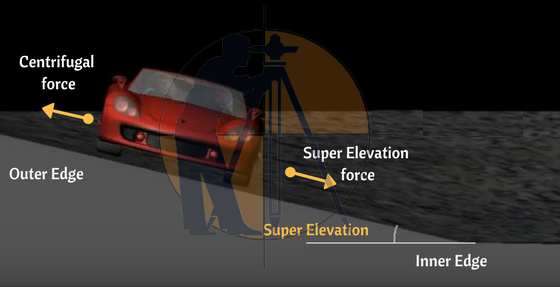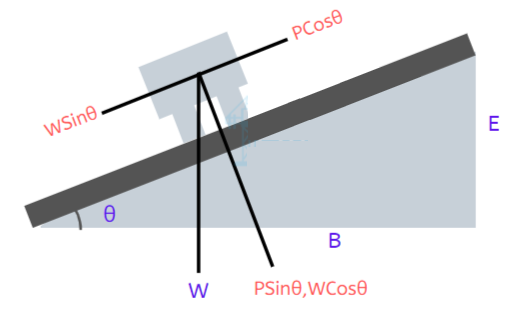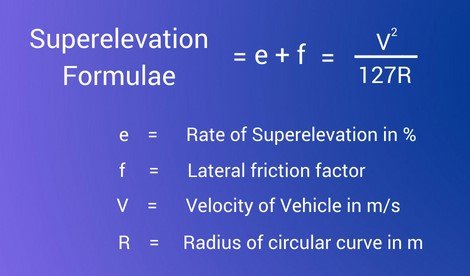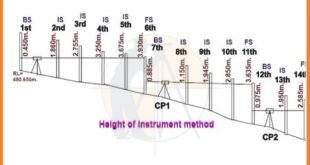Super-elevation And Design Formula | Advantages | Highway Engineering
-
Super-elevation or Banking of Road:-
-
Advantages of providing Super elevation:-
-
Derivation of Super Elevation :
-
Super Elevation formula:-
-
Design procedure of Super-elevation / Banking of road:-
-
Step – 1:-
-
Step – 2:-
-
Step – 3:-
-
Step – 4:-
Super-elevation or Banking of Road:-
When a vehicle travels in a circular path or curved path, it is subjected to an outward force which makes a vehicle to overturn and skid due to Centrifugal force. To overcome this force and for safe travel of a vehicle, the outer edge of the road is raised above the inner edge. This is known as Super-elevation or banking of road.

Super-Elevation / Banking of road reduces the effect of centrifugal force on the running wheels. If super-elevation is not provided with the entire centripetal force is produced by the friction between the vehicle’s tires and the roadway, thus results in reducing the speed of a vehicle.
Advantages of providing Super elevation:-
- Super elevation is provided to achieve the higher speed of vehicles.
It increases the stability of fast-moving vehicles when they pass through a horizontal curve, and it also decreases the stresses on the foundation. - In the absence of super elevation on the road along curves, potholes are likely to occur at the outer edge of the road.
- The Indian road congress(IRC) has prescribed the max value of Super Elevation is 1 in 15.
Learn More
What is Difference Between Whole Circle Bearing and Quadrantal Bearing
Derivation of Super Elevation :
As per the figure, the below forces are acting on a car
In order to find out the angle of elevation (Super Elevation) the “tan” formula is used

From above fig, tanθ = Opposite Side⁄Adjacent Side
therefore, tanθ = E⁄B
The below forces are acting on the vehicle as mentioned in figure:
Weight of the vehicle = W kg (↓) ;
Centripetal force = P (→);
Frictional forces = F1 & F2 (← );
You can check out the below figure more idea.

Hence, P.Cosθ = W.Sinθ+F1+F2
where F = fR
P.Cosθ = WSinθ + fR1 + fR2
= W.Sinθ + f(R1 + R2)
= W.Sinθ + f(PSinθ+WCosθ)
P.Cosθ-f.PSinθ = W.Sinθ+f.WCosθ
Divide with “W.Cosθ”;
(P.Cosθ-f.PSinθ)⁄W.Cosθ = (W.Sinθ+f.WCosθ)⁄W.Cosθ
P⁄W -(f.P⁄W)tanθ = tanθ + f
P⁄W (1-f.tanθ) = tanθ+f
P⁄W = (tanθ+f)⁄1-f.tanθ
P⁄W = e + f
But, P⁄W = V2/ gR
Therefore, e + f = V2/ gR
Where,
e = rate of Super elevation in %
V = velocity of vehicle in m/s
f = lateral friction factor = 0.15
g = acceleration due to gravity = 9.81 m/s2
R = radius of circular curve in meters.
If velocity is in KMPH then e + f = V2/ 127R
Learn More
How To Calculate The Height Of Any Buildings And An Objects Using With Theodolite
Super Elevation formula:-

The above formula is used only to calculate one of the missing value either e or f or V or R for design purpose consider the below procedure.
Design procedure of Super-elevation / Banking of road:-
Design procedure includes following steps
Step – 1:-
Calculate the Super elevation (e) necessary for 75% design speed[0.75V] and assume no lateral friction is developed
As per practical conditions, it is suggested that super-elevation should be provided to fully counteract the centrifugal force due to 75% of the Design Speed(V) by neglecting lateral friction (f=0) developed.
Super Elevation formula = e + f = [V2]/127R
Consider lateral friction f = 0;
75% of design speed which means V= 0.75V
As per formula,
e + f = [V2]/127R
e + 0 = [0.75V]2/127R
e = V2 / 225R
Note: e value should not be more than 0.07
If the calculated value (ecal) is less than (emax) then consider the value of (ecal) if not proceed to next step,
if (ecal<emax) then e = ecal
If the calculated value (ecal) is greater than (emax) then consider the value of (emax)
if (ecal<emax) then e = emax
Step – 2:-
Lets assume e = emax = 0.07 and proceed to next step.
Step-3: Calculate the value of friction for ‘e’ Value
Super Elevation formula = e + f = [V2]/127R
= 0.07 +f = [V2]/127R
f = [V2]/127R – 0.07
Learn More
How To Calculate The Horizontal Distance Using With Auto Level Machine
Step – 3:-
From the above step we found the value of e. Now lets find the value of the lateral friction (f) for the known value of emax Value
Super Elevation = emax + f = [V2]/127R
= 0.07 + f = [V2]/127R
fcal = [V2/127R] – 0.07
If fcal < fmax (0.15)
Then fcal = f ;
If fcal > fmax (0.15)
Then e = 0.07 is safe.
But if fcal > 0.15
Then fcal =fmax (0.15)
Step – 4:-
Lets calculate the value of Restricted Speed (Va)
Therefore V = Va
Super Elevation = e + f = [V2]/127R
= 0.07 + 0.15 = (Va)2/127R
V = [127R(0.22)]1/2
If Va > V then e = 0.07, f = 0.15
If Va < V still e = 0.07 and f = 0.15 but the speed restriction board is provided along with consists the value of Va

 Surveying & Architects A unique platform of Civil Engineering
Surveying & Architects A unique platform of Civil Engineering

One comment
Pingback: Basic Thumb Rules For Civil Engineers - Surveying & Architects